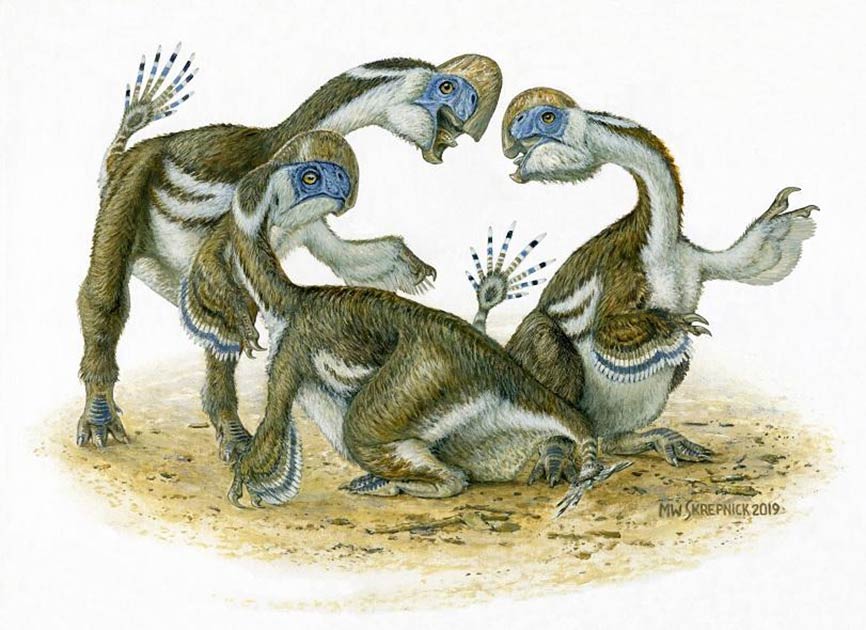
Buried beneath the sands of Mongolia’s Gobi Desert for 68 million years, multiple skeletons of a new species of feathered, two-fingered, toothless dinosaurs have been unearthed by a team of researchers. Dubbed the Oksoko avarsan, this remarkable creature is thought to be a key ‘missing link’ and is already helping to demystify dinosaur evolution.
Two Digits and a Parrot’s Beak
The discovery of the group of new dinosaur skeletons, and their subsequent analysis, has helped to fill a range of gaps in the dinosaur evolutionary tree. While many dinosaurs have been found in Mongolia’s Gobi Desert, this one is extra special for a several reasons.
Achieving heights exceeding two meters, this dinosaur weighed about 45 kilograms (99 pounds). The Oksoko avarsan fed on plants and animals with its large, toothless beak, that is described as being similar to that of a parrot. This bizarre-looking ancient creature had two digits protruding from each forearm, similarly to a T-Rex.
This is the aspect of the discovery that the research scientists found most interesting, for these fossilized skeletons represent the first tangible evidence of digit loss in the three-fingered oviraptor family, an adaptation which the researchers say enabled the species to spread across vast distances during the Cretaceous.

This newly discovered species has just two fingers and no teeth, as can be seen in this skeletal anatomy of Oksoko avarsan. (Gregory F. Funston et. al / CC BY-SA 4.0)
The Underworld of the Desert Raptors
This description of the dinosaur comes from a new study published in the journal Royal Society Open Science written by Dr. Gregory Funston, of the University of Edinburgh’s School of GeoSciences, Philip J Currie of the Dinosaur Museum in Canada and a team of researchers from Hokkaido University in Japan and the Mongolian Academy of Sciences. According to the paper, it was the fact that this creature had two digits which “revealed some unexpected trends.” These have already helped to answer the question of why oviraptors were so diverse before the mass-extinction event that eventually brought the dinosaurs to extinction.
The Gobi Desert is a large brushland region in East Asia, covering parts of Northern and Northeastern China, and of Southern Mongolia, and it is notable in history as hosting several important trading stations along the Silk Road. However, according to Amicus Mongolia, beneath the scattered layers of early medieval archaeology, many world-famous fossils have been recovered from Gobi Desert providing many clues into dinosaur evolution, including the “two fighting dinosaurs (Velociraptor and Protoceratops)”, the “crowded infant dinosaurs – Protoceratops”, “Oviraptorosaur laying its eggs”, “Giant carnivorous Tarbosaur and its baby” and “egg fossils of many different dinosaur species, and an embryo in egg.” Oviraptor, meaning “egg-plunderer,” is a genus of small Mongolian theropod dinosaurs that was visually the most bird-like of the theropod dinosaurs and had three fingers.

Image of skeletons discovered in the Gobi Desert. In the lower diagram, the different colors represent different individuals. (Gregory F. Funston et. al / CC BY-SA 4.0)
The Gobi as an Ancient Dinosaur Generator
Perhaps one of the most fascinating dinosaur facts, provided by Amicus Mongolia, is that if one was to take into account all of the dinosaur research conducted on the planet over the last decade, when totaled, it is estimated that more than “80 genera of dinosaurs, or 1/5 (one fifth) of the over 400 dinosaur genera known to science, have been found in the Mongolian Gobi.”
However, no matter how stiff the competition is, this new species is an exceptionally rare and valuable find. Thanks to its two digits, Oksoko avarsan is thought to have adapted its diet and lifestyle, which ultimately enhanced its breeding success. The research team also concluded that these prehistoric creatures were social beings when young, as the excavators discovered a group of four juveniles together.
The team of scientists studied the slow reduction, and eventual loss of, the dinosaur’s third finger across the oviraptors’ evolutionary history and concluded in the study that the newly discovered creatures’ arms and hands “changed drastically in tandem with migrations to new geographic areas, specifically to what is now North America and the Gobi Desert.” When attempting to answer why this bird-like creature lost its third finger, the researchers suspect this most likely occurred in relation to changes in its foraging or nesting patterns, display requirements or other social habits.
Top image: An artist’s impression of the Oksoko avarsan dinosaur. Source: (Michaeol Skrepnick / University of Edinburgh)